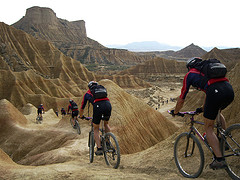
flic.kr/p/5yoGVr
One of the first things that a cyclist needs to know is the importance of setting the correct tire pressure in mountain bikes. A tire that is correctly inflated provides the cyclist control and makes the ride smooth. In contrast, low pressure increases the danger of getting a flat tire and makes cycling harder, while high pressure makes the bike bumpy and uncontrollable.
The tire pressure varies according to the condition of the tire, the condition of the mountain trail , the personal preferences of the rider, and the type of terrain. You can regulate the tire pressure by purchasing a good quality bicycle pump. Also, you need an accurate gauge to get the pressure readings.
Now, you can inflate the tire according to the manufacturer’s specifications and see how the bicycle runs. Then, you can adjust accordingly. It is best that you use the same gauge and pump, because different gauges will give you different readings.
|
Learn how to ride faster than you ever thought possible |
A good strategy is to start with a higher pressure. This means 40-50 psi (3-3.5 bar, then lower the pressure to find out which pressure suits your bike most. If you are on the heavier side, you should also use higher pressure.
The best method to determine tire pressure is to take a test ride. Observe the tire behavior, how it slides on the mountain, how it hooks up in corners, how it runs on the dirt track.
If the pressure is more, reduce it by 5psi in each tire. If the new pressure compares well, is more stable and the grip on the ground has improved, then you should set it as the standard pressure. Otherwise, drop the pressure marginally and run the test again.
To know the lowest pressure, observe how you can ride without getting flat tires. Normally, a tire flattens when the tire compresses against some object and the tube gets damaged.
If the system is tubeless, it is recommended to use lower pressure, say 30 to 40 psi. In tubeless tires, the danger of pinch flats is less and even an occasional rim contact is not alarming. Therefore, you can run on much lower pressures. Just be extra careful not to dent the rims or burp air out along the bead. When you are on too low pressure, the tire will roll under the rim when maneuvering on hard corner.
Another balancing test is to observe rolling resistance with lower pressure. The extra rolling resistance requires extra efforts but it provides increased control and climbing traction. For cross-country racers, better efficiency is more important than better control.
Squeezing the tire with hand gives the feel of the pressure and is a common technique to determine the air requirement.
Tagged with: bicycle type • mountain bike
Filed under: Bikes